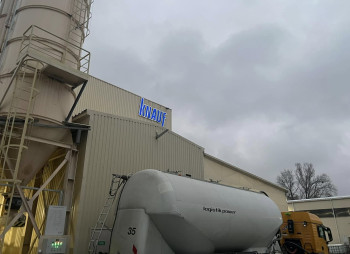The European Bank for Reconstruction and Development (EBRD) deployed a record amount of nearly €2.4 billion in Ukraine in 2024, following a €2.1 billion total in 2023. The EBRD, Ukraine’s biggest institutional investor, which substantially raised investment in Ukraine after the full-scale Russian invasion in February 2022, has made a total of nearly €6.2 billion available to Ukraine in wartime.
The EBRD prioritises support for energy security, vital infrastructure, food security, trade and the private sector in its work in Ukraine, counting both investments and trade finance in its deployed figure.
In 2024, the EBRD deployed a record €833 million of financing via partner financial institutions in Ukraine, including €472 million to support trade finance under its Trade Facilitation Programme. Portfolio risk sharing remained the main instrument for EBRD to deliver finance to Ukrainian businesses, with the EBRD remaining the leading provider of such guarantee facilities in the country.
The EBRD works with donors in Ukraine. Since 2022, the EBRD has succeeded in mobilising more than €2.6 billion in donor funds for Ukraine, including unfunded guarantees, of which nearly €1 billion was in 2024 alone. Leading donors since 2022 have been the European Union, United States of America, France, Norway and The Netherlands. In 2024, leading donors were the European Union, France, Norway, South Korea, Sweden and The Netherlands.
Following agreement in 2023 to increase the Bank’s paid-in capital by €4 billion to sustain support for Ukraine, the EBRD’s investment levels are expected to continue at around €1.5 billion a year, with potential for further increases when the time comes for reconstruction.
“Our shareholders have expressed enormous confidence in us by agreeing to a substantial capital increase for our activity in Ukraine and affected countries. I would like nothing more than for 2025 to be a year of reconstruction. This is where the EBRD can be at its best – using our financing knowledge and experience to build back better,” said EBRD President Odile Renaud-Basso.
Among highlights of EBRD work in Ukraine in 2024 were a highly innovative war risk insurance guarantee scheme designed to support trade despite the conflict; participation in a US$ 435 million telecoms deal that is bringing the country its biggest foreign direct investment in wartime; private-sector finance for postal services to Nova Post, pet food to Kormotech and bionic prosthetics to Esper Bionics; work on reintegrating war veterans into the economy and enhancing human capital (with 40.3 per cent of projects gender-tagged), as well as major lending to the energy, infrastructure, banking and municipal sectors.
To mitigate the widespread electricity shortages Ukraine is experiencing as a result of Russian attacks on its power generation system, the EBRD focussed its energy investments on financing for decentralised small-scale generation capacity helping ensure uninterrupted energy supply to Ukrainian people and businesses.
EBRD energy financing has reached €2 billion since 2022, of which €639 million was signed last year.
The Bank lent €80 million to Ukrnafta, a Ukrainian state-owned oil and gas company, to finance supplying and installing a total of about 100 MW of small-scale gas-fired distributed power and co-generation capacities around the country and boost the resilience of the power sector.
The EBRD financed new players entering the energy generation market. A €180 million loan to Ukrainian Railways (Ukrzaliznytsia, or UZ) to install small-scale generators around the country, will finance the supply and installation of up to 270 MW of decentralised small-scale gas-fired power generation capacity.
Early in the year, the Bank also signed a €200 million loan package to Ukraine’s main hydropower generation company, Ukrhydrenergo, to mitigate the impact of repeated Russian attacks. An EBRD loan of €100 million backed by a concessional parallel loan of €100 million from Italy provided emergency support to restore and maintain the company’s electricity production.
A parallel approach for supporting the nation’s energy resilience was through partnerships with Ukrainian financial institutions. The €700 million Energy Security Support Facility (ESSF), launched in September, was designed to support investments in decentralised energy generation, energy storage, and energy efficiency projects of Ukrainian businesses, regional municipalities and households. In the first three months since the launch of this programme, the EBRD signed or approved €525 million worth of financing agreements with four partner banks.
The heating needs of Ukrainian municipalities were prioritised in loans of €50 million to Kyiv, €25 million to Kharkiv, as well as municipal lending to the cities of Kryvyi Rih, Mykolaiv and Lutsk. These will be used to provide liquidity for municipal district heating as well as water treatment and transport utilities.
With an eye to the country’s longer-term energy future, the EBRD also supported Ukraine’s ambitions for more renewable energy.
The Bank lent €60 million to fuel distributor Galnaftogaz for its first private biofuels investment in wartime, to support the domestic production of bioethanol, whose greenhouse gas emissions are 70 per cent lower than traditional fuel.
And it established a renewable energy joint venture with an experienced German solar energy company, GOLDBECK SOLAR Investment, to construct and operate new solar PV project in Ukraine.
In transport infrastructure, a separate €300 million loan to Ukrainian Railways will help the company upgrade its locomotives, to ensure stable and uninterrupted railway cargo operations for agricultural exports and critical imports as well as passenger services.
To improve road connections between Kyiv and its European Union neighbours, €267 million of an existing loan for road development was reallocated for emergency repairs on the M-06 road heading west to Slovakia and Hungary, which has experienced an upsurge in traffic in wartime.
Beyond financing, the EBRD continues to support Ukraine’s reform drive – a crucial step not only to unlock further investments from the private sector, but crucially, to progress on Ukraine’s aspiration to become an EU member.
Through the Ukraine Reform Architecture and the Business Ombudsman, the Bank has been working with government and public bodies on issues related to EU integration and alignment with EU regulation, while the digital procurement platform ProZorro has improved the transparency and efficiency of public procurement.
The EBRD is also helping Ukraine prepare to effectively absorb the vast financing that reconstruction is expected to bring. Together with the European Investment Bank (EIB) and the World Bank, it is helping ministries and agencies build institutional capacity and providing technical assistance in the State Agency for Restoration and Infrastructure Development of Ukraine to establish an effective Project Delivery Unit.
The EBRD’s overall financing in 2024 reached a record level of €16.6 billion, a jump of 26 per cent from the previous record of €13.1 billion in 2023. The Bank’s financial results are expected to be announced in the spring.






